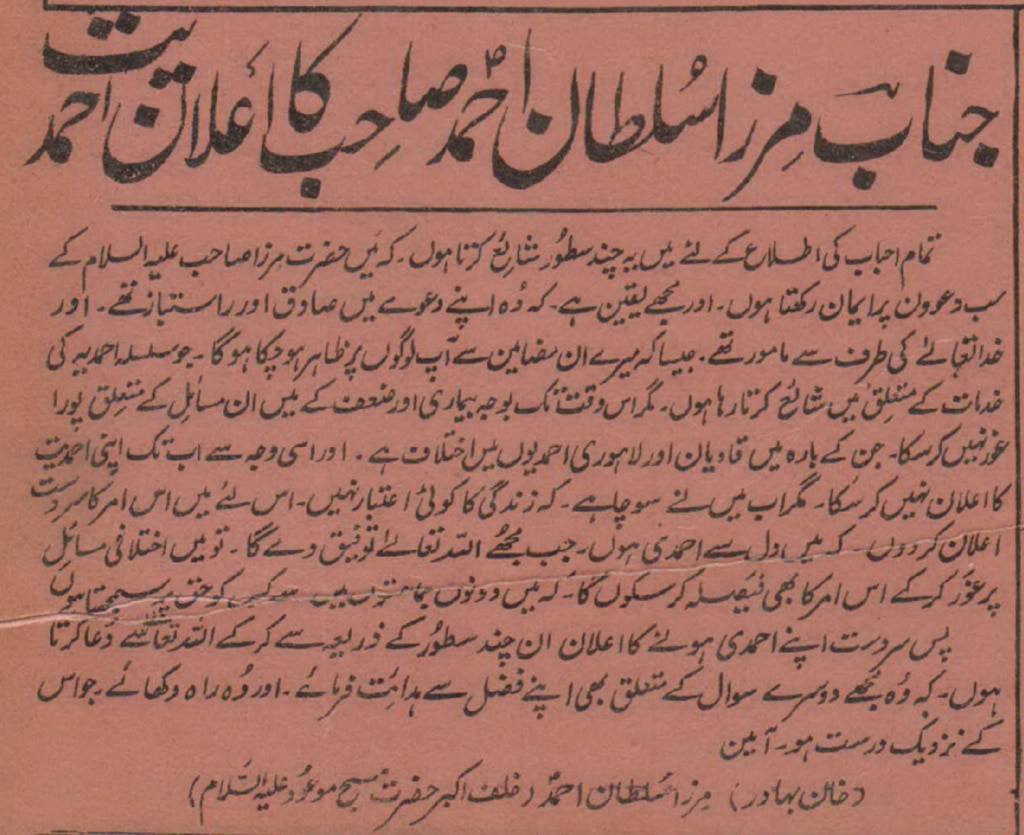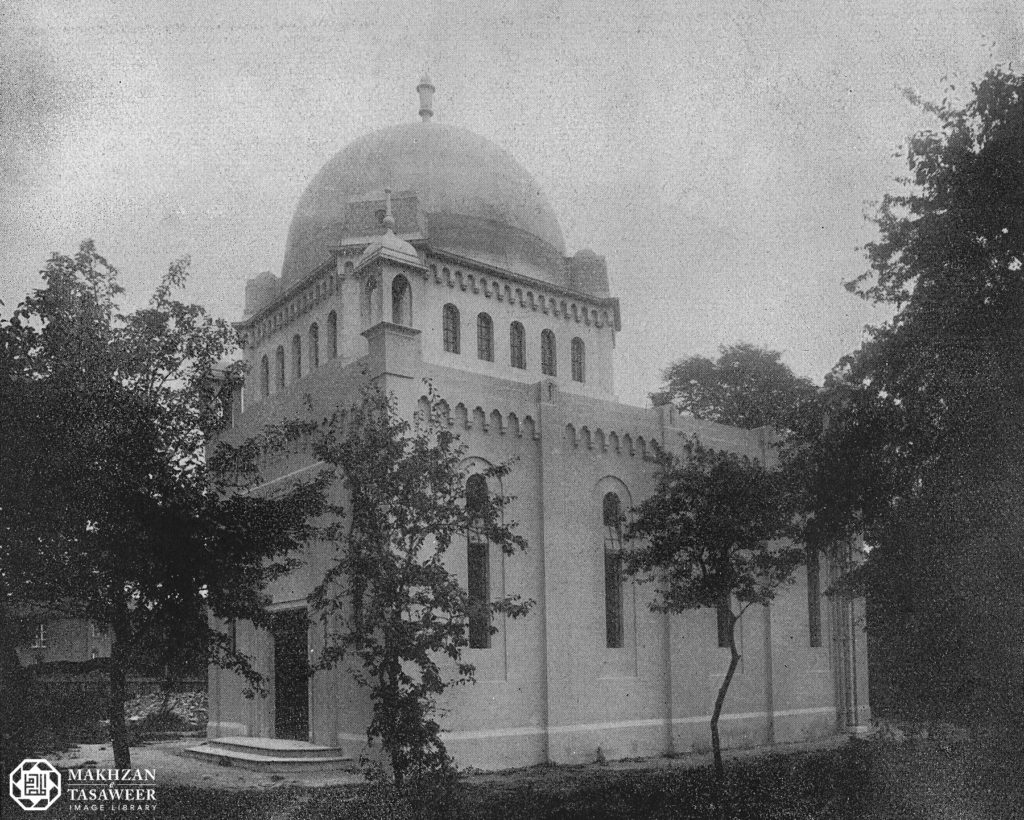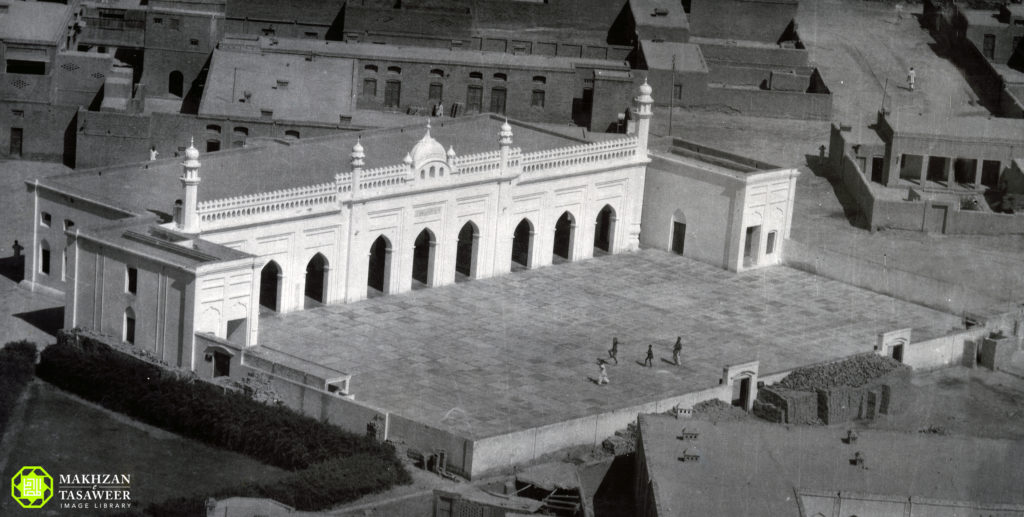27 September 1937: Hazrat Musleh-e-Maudra laid the foundation stone of a guest house in Qadian which began to serve guests after it was completed the following year.
27 September 1946: Hazrat Musleh-e-Maudra and Mahatma Gandhi had a meeting in Delhi on this date to discuss communal and national affairs.
28 September 1924: Hazrat Musleh-e-Maud’sra article about the holy life of the Holy Prophetsa was read out in London.
29 September 1933: Jamaat-e-Ahmadiyya Bengal had its 17th Jalsa Salana which was blessed by Hazrat Mirza Sharif Ahmadra as the chief guest from the Markaz. Hazrat Musleh-e-Maudra sent a special message to be read out.
29 September 1938: Hazrat Maulvi Ubaidullah Bismilra passed away. The Promised Messiahas gave him the name “Firdausi” as an honour and a reference to his deep knowledge of Persian.
29 September 1946: Hazrat Musleh-e-Maudra addressed a convention of Khuddam-ul-Ahmadiyya Delhi.
29 September 1951: Jamaat-e-Ahmadiyya Indonesia was holding its Jalsa Salana and requested Hazrat Musleh-e-Maudra for a message. Upon this, Hazrat Musleh-e-Maudra sent a special message addressing these devout members of the Jamaat.
30 September 1917: Jamaat Shimla held its Jalsa which was graced by Hazrat Musleh-e-Maudra. He also delivered a speech about the signs of living religions and openly challenged leaders of faith groups to a contest in the acceptance of prayers.
30 September 1929: Hazrat Musleh-e-Maudra delivered a speech in Jammu Kashmir.
30 September 1935: Hazrat Musleh-e-Maud’sra nikah with Syeda Maryam Siddiqa Sahiba was announced by Hazrat Mufti Muhammad Sadiqra in Qadian.
October 1901: Hazrat Khalifatul Masih I’sra book Khutut Jawab-e-Shia wa Rad-e-Naskh (Letters in reply to a Shia [Muslim] and the rebuttal of abrogation [of Quranic verses]) was printed.
October 1908: Hazrat Khalifatul Masih Ira carried out Etikaf in Ramadan. He would deliver dars of three parts of the Holy Quran daily. Hazrat Mirza Bashiruddin Mahmud Ahmadra also did Etikaf this year.
October 1909: Hazrat Sheikh Muhammad Yousufra started publishing a newspaper from Qadian titled Nur. The newspaper’s aim was for tabligh to Sikh people.
October 1915: The British government directed communities, tribes and groups to submit their preferred mode of settlement in lawsuits of inheritance. Jamaat-e-Ahmadiyya proposed that they desired to resolve their matters of inheritance through the guidelines of the Holy Quran instead of national norms.
October 1916: The companions of the Promised Messiahas were so passionate to spread the message of the true Islam that they would use every available mode of tabligh. This month, some new converts were reported from Nigeria and Sierra Leone after the tabligh of Hazrat Maulana Abdur Rahim Nayyarra, who would convey the message of Ahmadiyyat through letters to this far distant continent.
October 1924: Shahzada Abdul Majeed Khan established a mission of the Jamaat in Tehran at the end of this month.
October 1925: A concrete boundary was built around the part of Bahishti Maqbara in Qadian where the sacred tomb of the Promised Messiahas is situated.
October 1927: Hazrat Musleh-e-Maudra directed members of the Jamaat to establish a reserve fund of 2.5 million rupees. This was for tabligh works and other humanitarian activities of the Jamaat.
October 1929: Hazrat Musleh-e-Maudra issued a detailed statement against what the Sarda Act proposed. The Sarda Act was the Child Marriage Restraint Act, passed on 28 September 1929 by the Imperial Legislative Council of India. It fixed the age of marriage for girls at 16 and boys at 18, which was later amended to 18 for girls and 21 for boys. It is popularly known as the Sarda Act as it was sponsored by Harbilas Sarda. It came into effect six months later on 1 April 1930 and was applied to all of British India.
October 1941: Al-Haj Abdul Qadir Auda Sahib passed away in Palestine at the age of 112 years.
October 1943: The Muslim Supreme Council of Palestine issued a verdict unanimously, stating that a nikah announced by or of an Ahmadi should be registered and must be dealt with as all other sects of Islam.
October 1944: Malik Muhammad Sharif Sahib, a missionary in Italy, sent his first letter to Hazrat Musleh-e-Maudra after spending time in jail as a prisoner of war.
October 1945: Provincial elections to elect members of the legislative councils of British Indian provinces were fast approaching. A letter from a member of the Jamaat was received in Qadian, in which he requested Hazrat Musleh-e-Maudra for his guidance for the elections. Hazrat Musleh-e-Maudra instructed to support the candidates from the Muslim League. Nazir Umur-e-Ama sent a copy of the reply to Quaid-e-Azam who shared this reply with the press. The Muslim League’s organ, Dawn printed it in its 8 October 1945 issue.
October 1946: Communal riots occurred in the Bihar and Noakhali area, in which mobs robbed opponent camps ruthlessly. The Jamaat dispatched a large supply of humanitarian aid worth 50,000 rupees to the area. The following month, Hazrat Musleh-e-Maudra also sent medical assistance to those affected by the riots.
October 1947: One of most dreadful aspects of the partition of the Indian subcontinent was the abduction of women. In these circumstances, the members of the Jamaat in Qadian offered shelter and food for such misplaced women until May 1948, until their safe return to their families.
October 1947: Due to the partition and shift of the Markaz, financial cuts in foreign missions’ expenditures were inevitable. The Markaz sent a message of a possible temporary shutdown of the Spain mission to Maulana Karam Ilahi Zafar Sahib. However, he requested to run the mission without the monetary help of the Markaz. On being given permission, he sustained and managed the mission at his own expense, by selling perfumes.
October 1949: Jamaat-e-Ahmadiyya Switzerland commenced publication of its magazine Der Islam; the first issue consisted of three pages.
October 1952: Majlis Khuddam-ul-Ahmadiyya in Pakistan commenced publication of Khalid magazine. The first issue contained a special message by Hazrat Musleh-e-Maudra.
1 October 1938: Hazrat Musleh-e-Maudra started his journey from Qadian towards Hyderabad. This journey continued until 28 October and was based on a vision of his. The journey saw a series of lectures delivered by Hazrat Musleh-e-Maudra at various locations across India.
He reached Hyderabad on 16 October after stays in Sindh and Karachi.
On 20 October, Huzoor’sra arrival at Begumpet, an outskirt railway station of Hyderabad, was reported.
On 23 October, the famous Urdu writer, Mirza Farhatullah Baig invited Huzoorra to a special reception. The following day, Hazrat Musleh-e-Maudra visited Golconda and Bala Hissar area. Huzoorra also visited the Taj Mahal and Fatehpur Sikri in Agra.
1 October 1942: The National Islamic Salvation Federation’s representative, Sheikh Usman reached Qadian seeking guidance from Hazrat Musleh-e-Maudra. This organisation was thought to be the sole voice of Muslims living in China.
1 October 1942: Maulvi Muhammad Sharif Sahib reached Syria from Palestine to spread the message of the Jamaat.
1 October 1943: During his Eid-ul-Fitr Sermon, Hazrat Musleh-e-Maudra exhorted members of the Jamaat to expand their efforts of tabligh.
1 October 1943: Sheikh Amri Ubaidi Sahib from Tanzania commenced his missionary activities after joining the missionaries already serving there.
1 October 1952: Hazrat Musleh-e-Maudra urged members of the Jamaat to perform Hajj.
2 October 1924: Hazrat Musleh-e-Maudra travelled to the shore in England where William the Conqueror landed. This was to fulfill his vision he had some years ago where he was called “William the Conqueror”.
2 October 1928: Hazrat Musleh-e-Maud’sra stance on the Nehru Report started being published in Al Fazl under the title, Nehru Report aur Musalmano key Masaleh. These views were continuously published in Al Fazl until 2 November. On 5 October, Huzoorra asked the people of India to hold processions and prepare declarations against this biased and potentially harmful report. Hazrat Musleh-e-Maudra sent Malik Ghulam Farid Sahib MA to Bengal with the mission to raise awareness about this report. The views of Hazrat Musleh-e-Maudra were later published in book form.

2 October 1928: Hazrat Mirza Sultan Ahmad announced his allegiance with Jamaat-e-Ahmadiyya through an announcement in Al Fazl. Furthermore, he joined the Jamaat at hand of his brother, Hazrat Musleh-e-Maudra in 1930.

2 October 1947: The situation in Qadian after the partition of the Indian subcontinent continued to intensify to such an extent that Qadian was deemed too dangerous to live in. The Darwesh staying in Qadian to protect its sacred places were not permitted to use flour mills. For many days, they survived on boiled wheat. The police had also seized buildings of the Degree College and Fazl-e-Umar Research Institute. A bomb was thrown in the premises of Masjid Aqsa, which injured a youth badly. Government officials had already taken control of the residence of Hazrat Musleh-e-Maudra situated in Dar-ul-Hamd.
It is reported that on this date, Hazrat Musleh-e-Maudra directed concerned Jamaat officials in Lahore to arrange daily physical exercise for the workers of Jamaat offices. Hazrat Mirza Mansoor Ahmad was assigned to supervise these exercises.
3 October 1924: Hazrat Musleh-e-Maudra addressed the concluding session of the Conference of World Religions held in Wembley. On the same evening, he also called a special session of Shura to discuss The Review of Religions magazine about the selection of topics and various other matters.
3 October 1926: The Fazl Mosque, London was inaugurated by the famous Muslim leader, Sir Sheikh Abdul Qadir Sahib.

3 October 1946: On this date, Hazrat Musleh-e-Maudra had a detailed meeting with the All India Congress leader, Maulana Abul Kalam Azad. A look at Huzoor’sra busy schedule tells us that he had continuous meetings with the national leadership until 5 October. For example, he met the Nawab of Bhopal, Khawaja Nazimuddin, Sardar Abdur Rab Nishtar, Sir Feroz Khan Noon and Muhammad Ahmad Said Khan Chhatari etc.
On 5 October, Hazrat Musleh-e-Maudra sent a letter to Lord Wavell, Viceroy of British India and conveyed his concerns and fears about unfolding happenings. After a few days, a second letter was sent. On 10 October, a third letter was also dispatched, and on the same day, Hazrat Musleh-e-Maudra held some separate meetings with Khawaja Hasan Nizami and Pandit Jawahir Laal Nehru as well as with members of the media about the emerging political atmosphere of the subcontinent.
On 9 October Hazrat Musleh Maudra addressed a public gathering in Delhi on what religion draws us to in times of distress.
3 October 1947: Thousands of criminals, backed by the police force, attacked Qadian and tried to march towards the heart of the town. Ahmadi youth assigned to safeguard Qadian showed great courage and bravery.
3 October 1949: The foundation stone of Masjid Mubarak in Rabwah was laid.


